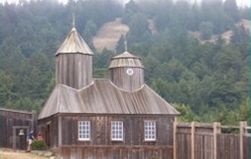The Indomitable Chapel
situated directly over the fault, was shaken and fell. The Chapel collapsed. In 1917 the chapel was rebuilt, using wood from the original structure, as part of the overall on-going restoration of the historic site. Just as the restoration was completed. Russia's last monarch, Czar Nicholas II, was deposed by Communist zealots. He and his fancily were executed the following year.


Page 2
read the funeral service." He added he found no information "respecting a chaplain or regular chapel services."
Continued from Page 1
Russian-Alaskan pioneer, Father Ioann Veniaminov who would later be canonized St. Innocent, spent five weeks at the Fort in 1836. His diaries reflect his impressions of the chapel built from money provided by "the officers and crew of the frigate Kreiser who donated a considerable sum toward the building" of the chapel. Finding the chapel "rather plain." he questioned 'just' how these funds were used. Innocent wrote "the entire interior decoration consists of two icons in silver rizas." Without saying so directly, he clearly implies his belief that there were some financial shenanigans with the contributed funds. He added, "the answer is unknown." St. Innocent also noted the chapel "receives almost no income from its members or from those Russians who are occasional visitors." Since the chapel was located on lands "borrowed" from Spain and not owned by Mother Russia, the facility could not be consecrated as an official Russian Orthodox Church nor could it bear a holy name. It would always be just a "chapel."
The abandoned Fort was sold by the Russians to private landowners who turned the complex including the chapel into farm buildings. The chapel was converted into a barn for livestock. When visited some fifty years later by a Russian Orthodox bishop, he was revolted by the site of animal stalls inside the then "peeling, dark" chapel with "broken glass" in broken "window frames:" The bishop was disgusted with Graffiti scribbled on the walls by "visitors to the church." He wrote his "heat ached from pity and involuntary tears came to his eyes from the abomination of the desolation of a holy place."
In 1969 the chapel was listed on the National Historic Landmark Registry as architecturally significant. A year later, it was engulfed in an accidental fire and burnt to the around. The loss of the original workmanship and materials caused the chapel to be removed from the Registry-although the Foil in its entirety remains listed. In 1973,the Chapel was rebuilt according to its original plans with slight modifications.
The chapel at Fort Ross lacks the majesty of the great basilicas the beauty of the great cathedrals and the quaintness of ordinary neighborhood churches. This ugly duckling church has survived nearly two hundred years of verbal, environmental and physical abuse and still stands picturesquely on the scenic California north coast. It was built at a time when Old N-Vorld civilization marveled with wonderment at the reports of adventure. riches and conquests of the New IvVorld. Brave men and women risked their lives exploring the new continent's mysteries. As they did so, they brought with them their religious faith and built houses of worship-some great and big and majestic. Some, like the chapel at Fort Ross, were small and plairi-but all had the same purpose. None, though. have evidenced the indomitable spirit of the "rather plain" Chapel at Fort Ross.

Story By Daniel J. Demers All Rights Reserved ©Copynght 2010
Fort Ross Chapel Today
For More Info And Pictures Please Visit
In 1906 the Fort was acquired by the California State Park system. Two months later the infamous San Andreas Fault lurched beneath San Francisco and laterally along the California coast. Fort Ross,
E-MAIL ME ddemers901@sonic.net
